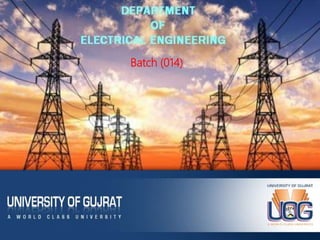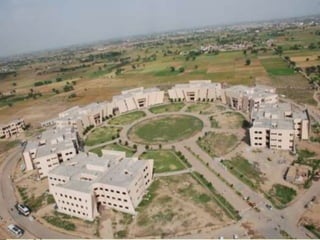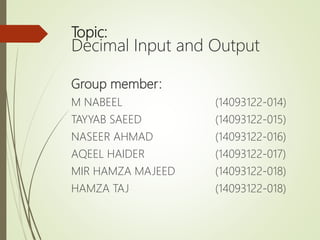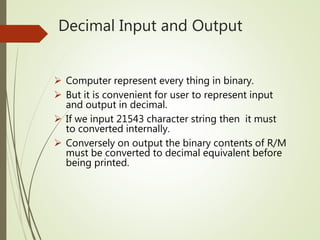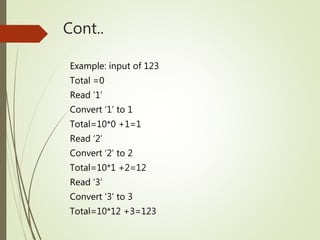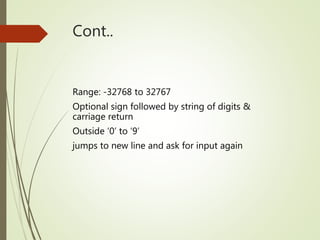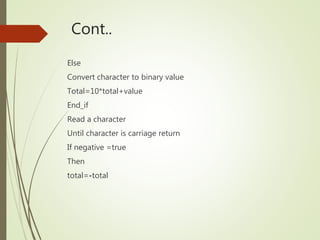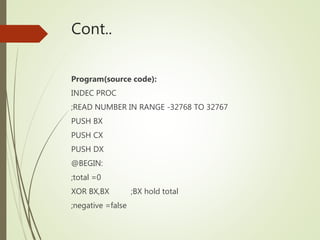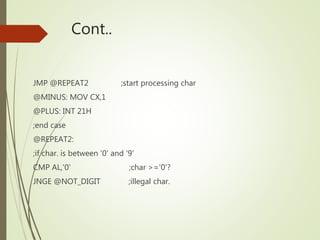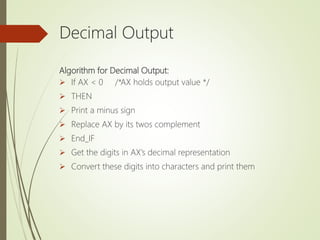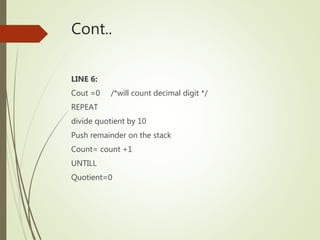assembly language programming organization of IBM PC chapter 9 part-2(decimal input,output)
- 2. Batch (014)
- 4. Topic: Decimal Input and Output Group member: M NABEEL (14093122-014) TAYYAB SAEED (14093122-015) NASEER AHMAD (14093122-016) AQEEL HAIDER (14093122-017) MIR HAMZA MAJEED (14093122-018) HAMZA TAJ (14093122-018)
- 5. Decimal Input and Output Computer represent every thing in binary. But it is convenient for user to represent input and output in decimal. If we input 21543 character string then it must to converted internally. Conversely on output the binary contents of R/M must be converted to decimal equivalent before being printed.
- 6. Decimal input Convert a string of ASCII digits to the binary representation of decimal equivalent For input we repeatedly multiply AX by 10 Algorithm (First version): Total=0 Read an ASCII REPEAT convert character to number Total=total*10+value Read a character Until character is carriage return
- 7. Cont.. Example: input of 123 Total =0 Read ‘1’ Convert ‘1’ to 1 Total=10*0 +1=1 Read ‘2’ Convert ‘2’ to 2 Total=10*1 +2=12 Read ‘3’ Convert ‘3’ to 3 Total=10*12 +3=123
- 8. Cont.. Range: -32768 to 32767 Optional sign followed by string of digits & carriage return Outside ‘0’ to ‘9’ jumps to new line and ask for input again
- 9. Cont.. Algorithm(second version): total=0 Negative=false Read a character Case character of • ‘-’: negative=true read a character • ‘+’: read a character End_case Repeat If character is not between ‘0’ to ‘9’ Then Go to beginning
- 10. Cont.. Else Convert character to binary value Total=10*total+value End_if Read a character Until character is carriage return If negative =true Then total=-total
- 11. Cont.. Program(source code): INDEC PROC ;READ NUMBER IN RANGE -32768 TO 32767 PUSH BX PUSH CX PUSH DX @BEGIN: ;total =0 XOR BX,BX ;BX hold total ;negative =false
- 12. Cont.. XOR CX,CX ;CX hold sign ;read char MOV AH,1 INT 21H ;case char of CMP AL,'-' ;minus sign JE @MINUS ;yes,set sign CMP AL,'+' ;plus sign JE @PLUS ;yes,get another char
- 13. Cont.. JMP @REPEAT2 ;start processing char @MINUS: MOV CX,1 @PLUS: INT 21H ;end case @REPEAT2: ;if char. is between '0' and '9' CMP AL,'0' ;char >='0'? JNGE @NOT_DIGIT ;illegal char.
- 14. Cont.. CMP AL,'9' ;char<='9' ? JNLE @NOT_DIGIT ;then convert char to digit AND AX,000FH PUSH AX ;save number ;total =total *10 +digit MOV AX,10 MUL BX POP BX ;retrieve number ADD BX,AX ;total =total *10 +digit
- 15. Cont.. ;read char MOV AH,1 INT 21H CMP AL,0DH ;CR JNE @REPEAT2 ;no keep going ;until CR MOV AX,BX ;store number in AX ;if negative OR CX,CX ;negative number
- 16. Cont.. Jz @EXIT ;no,exit ;then NEG AX ;yes,negate ;end if @EXIT: ;retrieve registers POP DX POP CX POP BX RET
- 17. Cont.. ;here if illegal char entered @NOT_DIGIT: MOV AH,2 MOV DL,0DH INT 21H MOV DL,0AH INT 21H JMP @BEGIN INDEC ENDP
- 18. Cont.. Output:
- 19. Input Overflow AX:FFFFh In decimal:65535 Range:-32768 to 32767 Anything out of range called input overflow For example: Input:32769 Total=327690
- 20. Cont.. Algorithm: total=0 Negative=false Read a character Case character of • ‘-’: negative=true read a character • ‘+’: read a character
- 21. Cont.. End_case Repeat If character is not between ‘0’ to ‘9’ Then Go to beginning Else Convert character to binary value Total=10*total
- 22. Cont.. If overflow Then go to beginning Else Total =total*10 +value If overflow Then go to beginning
- 23. Cont.. End_if End_if End_if Read a character Until character is carriage return If negative =true Then total=-total
- 24. Cont.. Code: ;total =total *10 +digit MOV AX,10 MUL BX CMP DX,0 JNE @NOT_DIGIT POP BX ADD BX,AX JC @NOT_DIGIT
- 25. Cont.. Output:
- 26. Algorithm for Decimal Output: If AX < 0 /*AX holds output value */ THEN Print a minus sign Replace AX by its twos complement End_IF Get the digits in AX’s decimal representation Convert these digits into characters and print them Decimal Output
- 27. Cont.. To see what line 6 entitles, suppose the contents of AX, expressed in decimal is 24168. To get the digits in decimal representation , we can proceed as follows, Divide 24618 by 10, Quotient= 2461, remainder=8 Divide 2461 by 10, Quotient= 246, remainder=1 Divide 246 by 10 , Quotient=24, remainder=6 Divide 24 by 10, Quotient=2, remainder=4 Divide 2 by 10, Quotient=0, remainder=2
- 28. Cont.. LINE 6: Cout =0 /*will count decimal digit */ REPEAT divide quotient by 10 Push remainder on the stack Count= count +1 UNTILL Quotient=0
- 29. Cont.. LINE 7: FOR count times DO Pop a digit from the stack Convert it to a character Output the character END_FOR
- 30. Cont.. Program Listing PMG9_1.ASM .MODEL SMALL .STACK 100H .CODE OUTDEC PROC ;prints AX as a signed decimal integer ;input: AX ;output: none PUSH AX ;save registers PUSH BX PUSH CX PUSH DX
- 31. Cont.. ;if AX < 0 OR AX,AX ;AX < 0? JGE @END_IF1 ;NO >0 ;then PUSH AX ; save number MOV DL,’-’ ;get ‘-’ MOV AH,2 ;print character function INT 21H ;print ‘-’ POP AX ;get Ax back NEG AX ;AX= -AX @END_IF1:
- 32. Cont.. ;get decimal digits XOR CX,CX ;CX counts digits MOV BX,10D ;BX has divisor @REPEAT1: XOR DX,DX ;prepare high word of dividend DIV BX ;AX=quotient, DX=remainder PUSH DX ;save remainder on stack INC CX ;count = count +1 ;until OR AX,AX ;quotient = 0? JNE @REPEAT ;no, keep going
- 33. Cont.. ;convert digits to character and print MOV AH,2 ;print character function ;for count time do @PRINT_LOOP POP DX ;digit in DL OR DL,30H ;convert to character INT 21H ;print digit ;end_for POP DX ; restore registers POP CX POP BX POP AX OUTDEC ENDP

